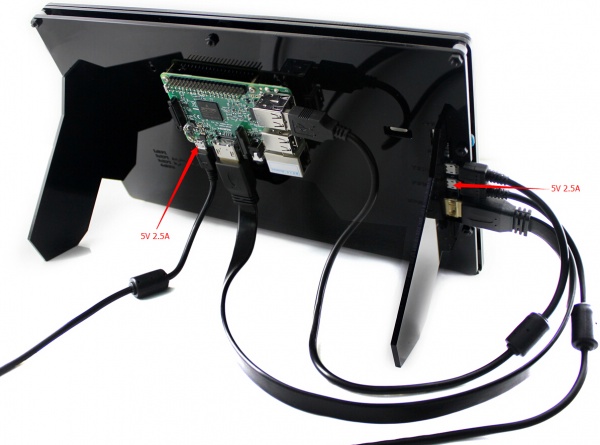- sales/support
Google Chat: zj734465502@gmail.com
- sales
+86-0755-88291180
- sales01
sales@spotpear.com
- sales02
dragon_manager@163.com
- support
tech-support@spotpear.com
- CEO-Complaints
zhoujie@spotpear.com
- sales/support
WhatsApp:13246739196
- HOME
- >
- ARTICLES
- >
- Common Moudle
- >
- LCD
10.1inch HDMI LCD (B) (with case) User Guide
Introduction
IPS, 1280×800, 10.1 inch Capacitive Touch Screen LCD, Supports Multi mini-PCs, Multi Systems
Holder assembly
Please refer to How to assemble 10.1inch-HDMI LCD (B) holder
Working with PC
This product supports Windows 10/8.1/8/7 OS. For the Windows 10/8.1/8 OS, the touch screen supports multi-touch up to 10 points. For some Window 7 OS, the touch screen supports single touch only.
Hardware connection
Please make sure the connections are done in a right sequence, or else the LCD may not work well.
- Connect the Power Only Port of the LCD to a 5V 2.5A power adapter with a Type A to micro USB cable.
- Connect the Touch port of the LCD to one of the USB ports on your PC.
- Connect the HDMI port of the LCD to the HDMI port on your PC with an HDMI cable
- When multiple displays are detected by your PC, the LCD can only be used to control the cursor on main display. So it is proposed to set the LCD as the main display.
Generally, you will see the screen displays the interface as the figure shows below. In this interface, slightly click the screen can perform the left-key mouse action, and long press the screen can perform the right-key mouse action. (You can also control the Back light of the screen with the back light adjustment button; see the mark 1 shows in the following figure.)
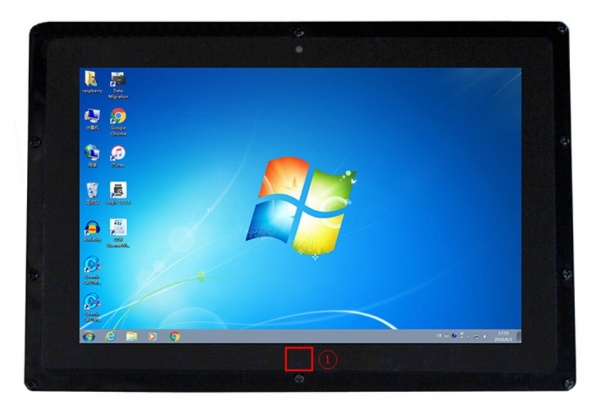
Touch Settings on Win 10 PC
Some users want to connect more than one display to their PC. Here we talk about how to setting the touch to make the touchscreen to control its screen separately.
- Connect touchscreen to PC. Here we use an standard PC monitor and connect an 7inch HDMI LCD (C) for example. We make the monitor as main screen and the touchscreen as secondary screen.
- By default,The touchscreen can only control cursor on the main screen. Here we set it to control the secondary screen
- Open Control Panel and search Tablet PC setting on the control panel and open the tool

- Click button "Setup..." to setting the touchscreen
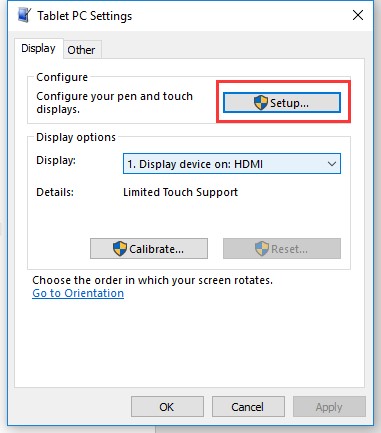
- After click the setup you can find that there is prompt on your first screen with white color background and other screens are white.

- If we want the touch of the touchscreen to control the desktop of the touchscreen itself. Just press Enter key to pass the first screen. And the second screen, when you find that the black text is displayed on the touchscreen, just touch the center of the touchscreen to finish this setting.
- After this setting, the touch on the screen will just control this touchscreen even thought it is not the main screen.
Note:
1 If the first screen and the second screen are touchscreen as well, you can touch them when the text is displayed on the screens. Then you can find that all the touchscreen can work.
2 This method is just tested on win 10 PC.
Working with Raspberry Pi
For the Windows OS on PC, the resolution of the LCD is automatically identified. Hence, you do not need to make the relative settings. When working with Raspberry Pi, you should set the resolution of the LCD by yourself, or else the LCD screen will not work. For more detail information, please read the following section.
At the beginning, you should download the latest image file, RASPBIAN or UBUNTU MATE, from the website: http://www.raspberrypi.org/downloads/.
- Download the image file (zipped) into your PC, and extract it, then you will get a file with the expansion name .img
- Connect a TF card to your PC, and format your TF card with the software SD Formatter. Notices: The capability of TF card in used here should be more than 4GB. In this operation, a TF card reader is also required, which has to be purchased separately.
- Start the software Win32DiskImager, and select image file downloaded in the first step, then, click the button Write to program the system image file.
- When the programming finished, open the config.txt file under the root directory in the TF card, and add the following lines at the end of the file. Then, save the modification and pop-out the TF card.
max_usb_current=1 hdmi_group=2 hdmi_mode=87 hdmi_cvt 1280 800 60 6 0 0 0 hdmi_drive=1
If you use the LCD with Raspberry Pi 4B, you need to remove line dtoverlay=vc4-fkms-V3D from config.txt file
if the statements above do not work properly, replace them with the following lines:
max_usb_current=1 hdmi_group=2 hdmi_mode=27
If the LCD is used for Raspberry Pi and there are "ghost images" on the LCD, try to comment or delete this line in the config.txt to fix such cases:
hdmi_drive=2
Hardware connection
- Connect the Power Only interface of the LCD to a 5V 2.5A power adapter with a Type A to micro USB cable (Normally, the LCD will perform screen-clear and self-checking. If there is nothing displayed on the screen, please check whether the LCD screen has been turned on. In case that the screen is ON, please check if the FFC cable is connected properly and in a good contact).
- Connect the HDMI interface of the LCD to the HDMI interface on your Raspberry Pi with a HDMI cable
- Connect the Touch interface of the LCD to one of the USB interfaces on your Pi.
- Insert a TF card into the TF card socket on the Raspberry Pi, and then power up the Pi. Waiting for a while, you may see the following interface. (Now, you can control the back light of the LCD with the back light adjustment button; see the mark 1 shows in the following figure.)
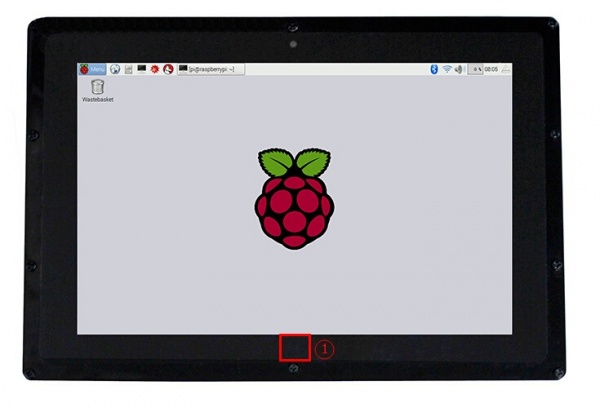
Rotation
Note: To rotate the touch, you can re-compile the kernel as well. There is an example for reference (use 7inch HDMI LCD (C).)
Display Rotating
To rotating the display, you can append this statement to the config file
display_rotate=1 #1: 90; 2: 180; 3: 270
Reboot the Raspberry Pi
sudo reboot
Touch rotating
With the operation above. The screen could rotate in display. However, the touch works improperly. To rotate the touch as display, you could do as below:
1. install libinput
sudo apt-get install xserver-xorg-input-libinput
2. create an xorg.conf.d folder
sudo mkdir /etc/X11/xorg.conf.d
3. copy file 40-libinput-conf to the folder which we created
sudo cp /usr/share/X11/xorg.conf.d/40-libinput.conf /etc/X11/xorg.conf.d/
4. Append a statement to touchscreen part of the file as below:
sudo nano /etc/X11/xorg.conf.d/40-libinput.conf
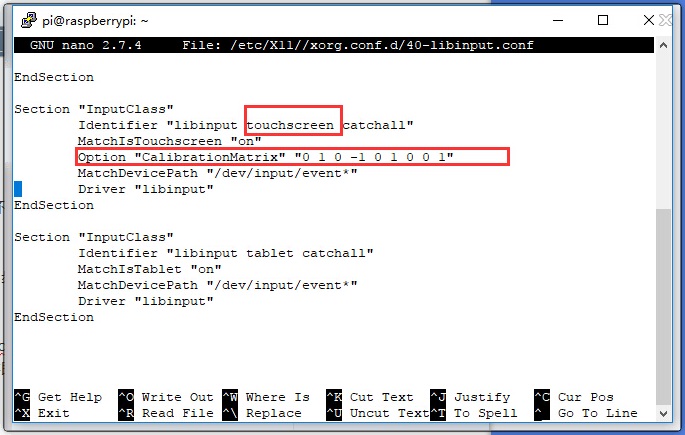
5. save and reboot your Pi
sudo reboot
After completing these steps. The LCD could rotate 90 degree both display and touch.
Note:
90 degree: Option "CalibrationMatrix" "0 1 0 -1 0 1 0 0 1"
180 degree: Option "CalibrationMatrix" "-1 0 1 0 -1 1 0 0 1"
270 degree: Option "CalibrationMatrix" "0 -1 1 1 0 0 0 0 1"




